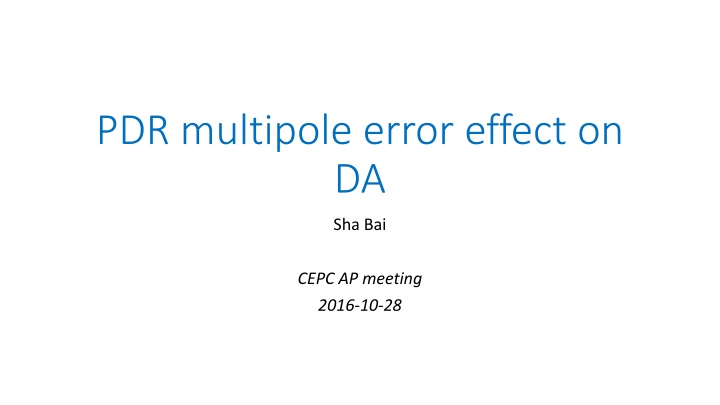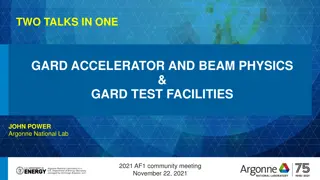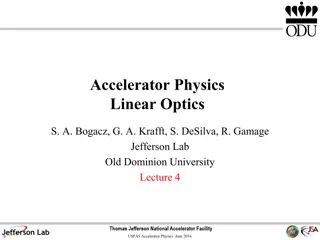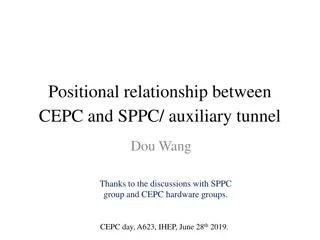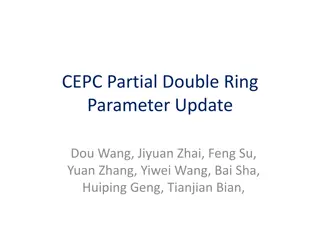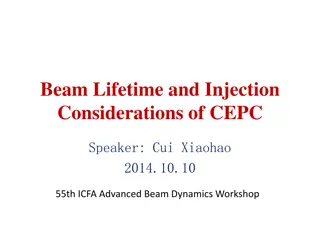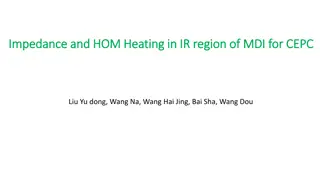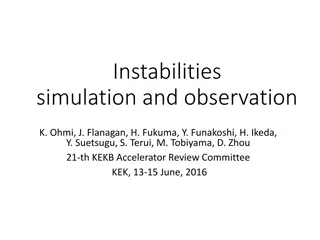Analysis of Multipole Error Effects on Beam Dynamics in CEPC Accelerator
The content discusses the impact of multipole errors on the beam dynamics at the CEPC Accelerator, focusing on sources of error, measurements, and potential effects on the beam. The analysis includes different types of multipole errors, their sources, and the resulting changes in tune and emittance due to these errors. Various scenarios are explored, such as the attachment of multiple multipoles to magnets and the setting of all magnets to be multipole. The study considers the effects of these errors both with and without damping, highlighting how they can alter the beam trajectory and properties over multiple turns of tracking.
Download Presentation

Please find below an Image/Link to download the presentation.
The content on the website is provided AS IS for your information and personal use only. It may not be sold, licensed, or shared on other websites without obtaining consent from the author.If you encounter any issues during the download, it is possible that the publisher has removed the file from their server.
You are allowed to download the files provided on this website for personal or commercial use, subject to the condition that they are used lawfully. All files are the property of their respective owners.
The content on the website is provided AS IS for your information and personal use only. It may not be sold, licensed, or shared on other websites without obtaining consent from the author.
E N D
Presentation Transcript
PDR multipole error effect on DA Sha Bai CEPC AP meeting 2016-10-28
Source Multipole error from two parts: Systematic: intrinsic of magnet geometric charactor Random: from manufacture, material character difference and pole tip difference etc on. Also the differences between individual magnet
BEPCII CEPC bend quad sext bend quad sext Dx(mm) 0.2 0.15 0.15 0.3 0.1 0.15 Dy(mm) 0.2 0.15 0.15 0.2 0.1 0.15 Tilt(mrad) 0.1 0.2 0.5 0.1 0.1 0.5 B*L 3e-4 3e-4 2e-3 5e-4 5e-4 4e-3 3e-4 8e-4 quadrupole (s) sextupole(s) 6e-4 5e-5 2e-4 6e-4 7e-5 6e-4 7e-5 5e-4 1.7e-3 Octupole(s) 5e-4 9e-5 2e-4 1.3e-4 6.9e-4 3.4e-3 Decapole(s) 6e-4 5e-4 1.4e-4 1e-3 6.5e-3 Dodecapol e(s) Quadrupol e(r) Sextupole(r) 1e-4 3e-4 2e-4 1e-4 1e-4 3e-3 2.9e-4 1.2e-3 1e-4 1e-4 3e-4 2e-4 1e-3 2e-2 Multipole(r)
DA with no error y y 140 dp p 2 120 dp p 1.5 100 dp p 1 dp p 0.5 80 dp p 0 dp p 0.5 60 dp p 1 dp p 1.5 40 dp p 2 20 x x 40 20 0 20 40 With damping Without damping
DA due to multipole error Attach two multipoles of each magnet y y y y y y 200 200 200 dp p 2 dp p 2 dp p 2 150 150 150 dp p 1.5 dp p 1.5 dp p 1.5 dp p 1 dp p 1 dp p 1 dp p 0.5 dp p 0.5 dp p 0.5 dp p 0 dp p 0 dp p 0 100 100 100 dp p 0.5 dp p 0.5 dp p 0.5 dp p 1 dp p 1 dp p 1 dp p 1.5 dp p 1.5 dp p 1.5 50 50 50 dp p 2 dp p 2 dp p 2 x x x x x x 40 20 0 20 40 40 20 0 20 40 40 20 0 20 40 Attach two multipoles of each magnet in SAD Tracking in 240 turns, Coupling factor =0.003 for emitty Three different seeds results Without damping Only normal multipole errors Tune has changed
DA due to multipole error B,Q,S all magnets set to be MULT y y y y 200 200 y y 200 dp p 2 dp p 2 150 150 dp p 1.5 dp p 2 dp p 1.5 150 dp p 1 dp p 1.5 dp p 1 dp p 1 dp p 0.5 dp p 0.5 dp p 0.5 dp p 0 dp p 0 100 100 dp p 0 100 dp p 0.5 dp p 0.5 dp p 0.5 dp p 1 dp p 1 dp p 1 dp p 1.5 dp p 1.5 dp p 1.5 50 50 dp p 2 dp p 2 50 dp p 2 x x x x x x 40 20 0 20 40 40 20 0 20 40 40 20 0 20 40 B,Q,S all magnets set to be multipole in SAD Tracking in 240 turns, Coupling factor =0.003 for emitty Three different seeds results Without damping Only normal multipole errors Tune has changed
DA due to multipole error Attach two multipoles of each magnet y y y y y y 200 200 200 dp p 2 dp p 2 dp p 2 150 150 dp p 1.5 dp p 1.5 150 dp p 1.5 dp p 1 dp p 1 dp p 1 dp p 0.5 dp p 0.5 dp p 0.5 dp p 0 dp p 0 100 100 dp p 0 100 dp p 0.5 dp p 0.5 dp p 0.5 dp p 1 dp p 1 dp p 1 dp p 1.5 dp p 1.5 dp p 1.5 50 50 50 dp p 2 dp p 2 dp p 2 x x x x x x 40 20 0 20 40 40 20 0 20 40 40 20 0 20 40 Attach two multipoles of each magnet in SAD Tracking in 240 turns, Coupling factor =0.003 for emitty Three different seeds results Without damping Normal and skew multipole errors
DA due to multipole error Attach two multipoles of each magnet y y y y 200 200 dp p 2 150 150 dp p 1.5 dp p 1 dp p 0.5 dp p 0 100 100 dp p 0.5 dp p 1 dp p 1.5 50 50 dp p 2 x x x x 40 20 0 20 40 40 20 0 20 40 20 seeds results join together 20 seeds results average Attach two multipoles of each magnet in SAD Tracking in 240 turns, Coupling factor =0.003 for emitty 20 seeds results Without damping Normal and skew multipole errors
DA due to multipole error B,Q,S all magnets set to be MULT y y y y y 200 y 200 140 dp p 2 dp p 2 dp p 2 120 150 dp p 1.5 150 dp p 1.5 dp p 1.5 dp p 1 100 dp p 1 dp p 1 dp p 0.5 dp p 0.5 dp p 0.5 dp p 0 100 80 dp p 0 dp p 0 100 dp p 0.5 dp p 0.5 dp p 0.5 dp p 1 60 dp p 1 dp p 1 dp p 1.5 dp p 1.5 dp p 1.5 50 40 50 dp p 2 dp p 2 dp p 2 20 x x x x x x 40 20 0 20 40 40 20 0 20 40 40 20 0 20 40 B,Q,S all magnets set to be multipole in SAD Tracking in 240 turns, Coupling factor =0.003 for emitty Three different seeds results Without damping Normal and skew multipole errors Tune has changed
DA due to multipole error B,Q,S all magnets set to be MULT y y y y 200 200 dp p 2 150 150 dp p 1.5 dp p 1 dp p 0.5 100 dp p 0 100 dp p 0.5 dp p 1 dp p 1.5 50 50 dp p 2 x x x x 40 20 0 20 40 40 20 0 20 40 20 seeds results join together 20 seeds results average B,Q,S all magnets set to be multipole in SAD Tracking in 240 turns, Coupling factor =0.003 for emitty 20 seeds results Without damping Normal and skew multipole errors Tune has changed
Conclusion With BEPCII multipole errors, the off-momentum dynamic aperture reduced quite obviously for both methods--- adding two multipoles of each magnet and set magnet to MULT. Adding two multipoles of each magnet, the off-momentum DA reduced to zero when introduce BEPCII multipole errors both of normal and skew component.
